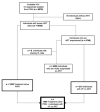Fostemsavir resistance-associated polymorphisms in HIV-1 subtype C in a large cohort of treatment-naïve and treatment-experienced individuals in Botswana
- PMID: 37823653
- PMCID: PMC10714836
- DOI: 10.1128/spectrum.01251-23
Fostemsavir resistance-associated polymorphisms in HIV-1 subtype C in a large cohort of treatment-naïve and treatment-experienced individuals in Botswana
Abstract
Fostemsavir (FTR) is a newly licensed antiretroviral drug that has been shown to have activity against HIV-1. The mechanism of action of FTR is different from all currently available antiretrovirals (ARVs), and as such, it offers hope for HIV-1 suppression in those people with HIV (PWH) who harbor HIV-1 variants with drug resistance mutations to currently used ARVs. Using 6,030 HIV-1 sequences covering the HIV-1 envelope from PWH in Botswana who are antiretroviral therapy (ART) naïve as well as those who are failing ART, we explored the sequences for FTR resistance-associated polymorphisms. We found the prevalence of FTR polymorphisms to be similar in both ART-naïve and ART-experienced individuals with VF in this setting, with no prior FTR exposure. Further studies on the phenotypic impact of these polymorphisms are warranted to guide how to monitor for FTR resistance.
Keywords: Botswana; HIV-1 C; drug-resistant mutations (DRMs); entry inhibitors; fostemsavir (FTR); polymorphisms.
Conflict of interest statement
The authors declare no conflict of interest.
Figures





References
-
- Parker E, Judge MA, Macete E, Nhampossa T, Dorward J, Langa DC, Schacht CD, Couto A, Vaz P, Vitoria M, Molfino L, Idowu RT, Bhatt N, Naniche D, Le Souëf PN. 2021. HIV infection in Eastern and Southern Africa: highest burden, largest challenges, greatest potential. South Afr J HIV Med 22:1237. doi:10.4102/sajhivmed.v22i1.1237 - DOI - PMC - PubMed
-
- World Health Organisation . 2021. HIV/AIDS
-
- Mine M. 2022. Botswana achieved the joint united nations programme on HIV/AIDS (UNAIDS) 95 ‐ 95 ‐ 95 targets: results from the fifth botswana HIV/AIDS impact survey (BAIS V). J Int AIDS Soc 25:231–232.
-
- Gaolathe T, Wirth KE, Holme MP, Makhema J, Moyo S, Chakalisa U, Yankinda EK, Lei Q, Mmalane M, Novitsky V, Okui L, van Widenfelt E, Powis KM, Khan N, Bennett K, Bussmann H, Dryden-Peterson S, Lebelonyane R, El-Halabi S, Mills LA, Marukutira T, Wang R, Tchetgen EJT, DeGruttola V, Essex M, Lockman S, Botswana Combination Prevention Project study team . 2016. Botswana's progress toward achieving the 2020 UNAIDS 90-90-90 antiretroviral therapy and virological suppression goals: a population-based survey. Lancet HIV 3:e221–e230. doi:10.1016/S2352-3018(16)00037-0 - DOI - PMC - PubMed
-
- Barak T, Neo DT, Tapela N, Mophuthegi P, Zash R, Kalenga K, Perry ME, Malane M, Makhema J, Lockman S, Shapiro R. 2019. HIV-associated morbidity and mortality in a setting of high ART coverage: prospective surveillance results from a district hospital in Botswana. J Int AIDS Soc 22:e25428. doi:10.1002/jia2.25428 - DOI - PMC - PubMed
MeSH terms
Substances
Grants and funding
LinkOut - more resources
Full Text Sources
Medical

